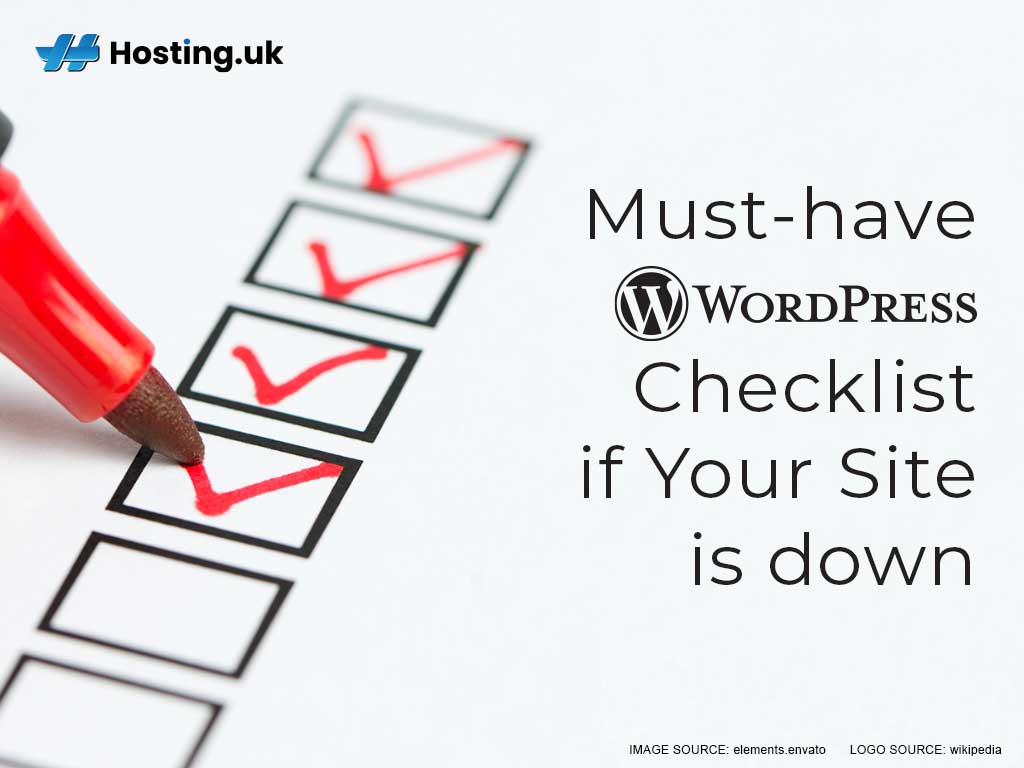A website or web service that’s down prevents end users from completing tasks and gets in the way of business. But, while most have little to no downtime, it is inevitable. It’s therefore important that you know what’s causing and how to prevent or fix the issue. It’s also important that you choose the best web host to manage your WordPress site to help reduce downtime.
Here are seven questions to check off your WordPress checklist if your site is down.
Table of Contents
Easy WordPress Checklist troubleshoot downtime
1. Verify if the website is ‘down for everyone’
Your website isn’t necessarily down every time it’s reported to be. It’s therefore important that you confirm it is before you take any steps. In some cases, it may be that an individual may not be able to load the site in the browser they’re using. There are many free tools to check this. One quick and easy way is to check sites like: isitdownrightnow.com or downforeveryoneorjustme.com. Or if you possess a handy tool like hosting.co.uk Website Monitoring, you’ll get a notification right away. Once you confirm that the website is actually down, move on to the other questions on your WordPress checklist.
2. Is the hosting server down due to maintenance?
Server maintenance is one of the more common reasons for your website being down. Because the hosting server is managed by your webhost, whenever it does a server maintenance, your website will be impacted.
Repair of server hardware and security risks are other factors that could cause your hosting server to be taken offline.
It doesn’t matter which of the above factors is responsible for your site being down, if it’s an issue with your hosting provider, contact them for assistance.
3. Was Your Domain Hijacked?
If step two didn’t fix the issue, the problem may stem from an issue with your domain.
It is possible that your domain has been hijacked which happens when an unauthorized person takes over ownership of your domain name. The intent is usually to keep your site offline or have it redirected to another website.
Here are some ways your domain could be hijacked.
- Security Breach – Your domain provider’s security was breached and that compromised your site.
- Vulnerable Credentials – Someone gained access using your username and password.
- Expired Registration – If your domain registration expired, someone could have bought and taken it over.
The easiest way to check if your domain has been hijacked is to contact your domain provider to get an update on the status of your domain.
4. Is Your Hosting Package Maxed Out?
Exceeding the limits of your hosting package could cause your website to go down.
While your allotted resources should be able to support your website, things such as hosting bandwidth and disk space can reach their maximum. Your hosting provider will generally notify you via email if this happens.
To get your site back online, simply upgrade your hosting package with the necessary resources required to successful run your site.
5. Is Your Theme and Plugins the Problem?
Crucial to your WordPress website operation is the theme and the plugins you’re using. And because WordPress Content Management System, CMS, is always changing, some themes and plugins may no longer be compatible.
This loss of compatibility to the core CMS can result:
- Loss off developer support
- theme or plugins are from an untrustworthy source
- Failure to update your theme or plugins
- Malware attack or other security breaches
If your theme or plugin is the problem, try re-installing your WordPress website using core files and add a theme and plugins that are verified.
6. Is Weak Security the Cause?
As mentioned before, you site could be compromised because your hosting provider’s security was breached or because of a subpar theme or plugin you may be using. But those are not the only security issues that could cause your site to go down.
These include:
- Not installing a security plugin to prevent cyber-attacks, etc.
- Vulnerable dashboard. Is it too easy to access?
- Too many people have access to your admin account. Did someone use public Wi-Fi or forgot to log out?
To reduce the likelihood of your site being impacted by these security issues, do:
- Install a reputable security plugin
- Use two-factor authentication
- Limit the number of people with access to your account
7. Did Your WordPress Configurations Change?
Changing your website’s settings can also cause it to go down. Whether deliberately or not, a small change can lead to big problems.
So, go ahead and troubleshoot your WordPress configurations to see if that’s the source of your site going down.
Summary
It’s generally better to be proactive than reactive. This means making sure you take all the necessary safety precautions from the get-go. Here are a few ways to do that.
- Ensure the host and domain provider you choose are reputable and of the highest quality.
- Think quality over quantity as it relates to themes and plugins. Use as few as possible and it may also be better to buy one.
- Make sure the codes you opt to use are clean and arrange your files correctly
Practicing these things from the initial stage is a great way to reduce the likelihood of your website going down. But if it does, you are now aware of the most common problems and may be able to quickly resolve it yourself or by someone else.
